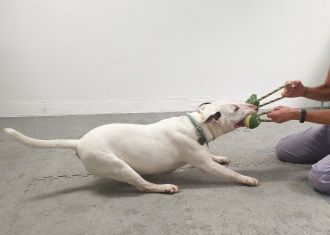Media release
From:
Animal behaviour: Dogs pawsitively hooked on toys
Some dogs show behaviours towards their toys that resemble behavioural addictions in humans, such as gambling and internet gaming, according to a study of 105 dogs published in Scientific Reports.
Behavioural addictions in humans are characterised by compulsive engagement with activities despite negative consequences. Although anecdotal evidence has previously suggested that some dogs display addictive-like behaviours towards toys — for example whining when a toy is out of reach and continuing to play despite overexertion or injury — this study represents the first published scientific evaluation of such behaviours in dogs.
Stefanie Riemer, Alja Mazzini and colleagues identified common symptoms of behavioural addictions in humans from previously published research, such as experiencing cravings and having difficulty stopping or controlling a behaviour. They then compared these with behaviours exhibited by 56 male and 49 female dogs — who were all described by their owners as motivated to play with toys — towards a toy selected by themselves at the start of the test. The dogs ranged in age from 12 months to ten years old and the most common breeds were Malinois (18 dogs), Border Collies (9 dogs), and Labrador Retrievers (9 dogs). The authors also surveyed owners about their dogs’ everyday behaviours towards toys.
The researchers report that 33 dogs exhibited addictive-like behaviours. These included being excessively fixated on their toy, showing a lack of interest in alternatives to their toy such as food or playing with their owner, making persistent efforts to access their toy when it was unavailable, and being unable to calm down for 15 minutes after all toys were removed. When their toy was inaccessible, these dogs tended to spend longer focusing on, and trying to access it, and to prioritise accessing it over consuming food or interacting with their owner.
The authors note that further research is needed to determine the reasons for dogs excessively engaging with toys and whether this can negatively impact their welfare.
Multimedia







 International
International


